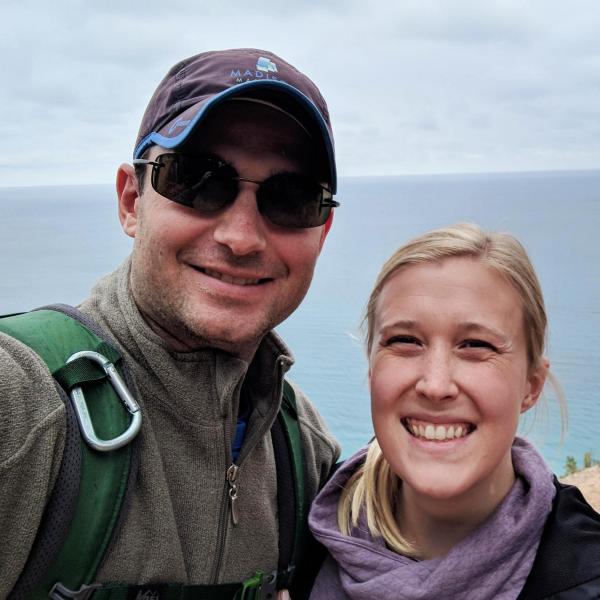
Throughout 2014, debra of America Young Leadership Committee member, Andrew Conrad, dedicated monthly posts to sharing his EB story. He wrote about what it was like when he was younger, his college days, the challenges he’s overcome, and how he continues to spread awareness for the disorder.
Hi, my name is Andrew Conrad and I am very familiar with the Debra organization having grown up with RDEB. Thank you Debra for giving me a platform to write about my life experiences living with recessive dystrophic EB. My Mom used to be involved in the foundation a great deal when I was younger. The foundation helped our family immensely growing up and I wanted to give back by blogging for the organization using my experiences with RDEB as a way to show that it is possible to live life to the fullest while managing this skin disease. My hope is that, through these posts, individuals with EB as well as families, can find encouragement and advice to make dealing with EB a little bit easier.
I am 27 and live in Chicago, IL. I have a younger brother who also has RDEB. I have been a fairly independent adult, essentially moving out of my parents’ house at age 18. My parents moved overseas to Singapore as I went to college as a freshman. I graduated from the University of Illinois with a degree in economics and now work for a medium-size commercial bank in Illinois as an AVP of Commercial Banking in and around the Chicago market. I am an avid cross-fitter working out 5 to 6 times/week. I was a 4-year varsity tennis player in high school and taught tennis all throughout my high school and college careers. Last November, I ran my first half marathon in Madison, Wisconsin finishing in 2 hours and 8 minutes. I have plans to run another half this year along with a few other races that might come my way throughout the year. It is my dream to tackle the Chicago Triathlon. I am also in love with travel. My goal is to travel to all 7 continents by age 30 having already knocked off 4 and going to South America, my 5th, this summer.
Despite all the things that I am still able to do, it isn't without its problems. I am grateful for all that I am able to do living with EB. I have figured out what I can and can't do and how to manage the things that I want to do even though it may hurt. I have had numerous EGD / dilatations due to strictures in my throat but as far as surgery goes, that is the extent of it, so I consider myself fairly lucky. Running, lifting, and playing tennis keep my hands and feet in constant pain, but I have coped by using various batting gloves, lifting gloves, multiple socks, and extra padded running shoes. I have found that the more active and in-shape I keep myself, the easier it is to manage EB. Diet has also been a big positive to EB management.
In the coming months, I plan to discuss in more depth some of the subjects that I have touched upon as well as try to answer questions from you. Please feel free to email me at staff@debra.org with any questions or comments. I will make every attempt to answer in upcoming posts. I want you to be encouraged and know that living with EB is not hopeless. With proper care and guidance you, too, can achieve much, much more than you thought possible.
For this month’s post, I was given the opportunity to view the new documentary Butterfly Girl, by director Cary Bell, about a girl named Abbie Evans. Abbie Evans was born with recessive dystrophic EB and the film follows her during her early adult life as she tackles the challenges that many of us with EB experience every day. The main focus of the film is her relationship with her parents as she shares time between her divorced mother and father, while Abbie attempts to become more independent. The film is currently on tour throughout the United States, debuting at last month’s SXSW film festival in Austin, TX. Chicago will have the honor of being another destination for the film, debuting at the Chicago International Movies and Music Festival on May 1. More information can be found at the festival website: cimmfest.org/butterfly-girl.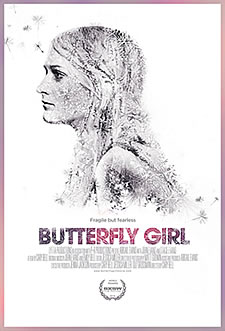 Being a person living with RDEB every day and going through many of the experiences that the film portrays made it; very difficult for me to sit down and watch the film all the way through. I try and live my life by requiring EB to take a backseat, so it’s not every day that I am presented with a film that brings so many memories of my childhood back to the forefront. Abbie’s first experience with EB occurred shortly after she was born as her doctor wiped her down and accidentally tore the skin from her lower leg. Some of the most telling experiences are detailed through her parents’ eyes as they were presented with the joy of having a new born baby girl, followed by the sudden shock of her being born with an extremely rare skin disorder. I imagine it to be very difficult for parents in this situation.
Being a person living with RDEB every day and going through many of the experiences that the film portrays made it; very difficult for me to sit down and watch the film all the way through. I try and live my life by requiring EB to take a backseat, so it’s not every day that I am presented with a film that brings so many memories of my childhood back to the forefront. Abbie’s first experience with EB occurred shortly after she was born as her doctor wiped her down and accidentally tore the skin from her lower leg. Some of the most telling experiences are detailed through her parents’ eyes as they were presented with the joy of having a new born baby girl, followed by the sudden shock of her being born with an extremely rare skin disorder. I imagine it to be very difficult for parents in this situation.
I was born in SW Memorial Hospital in Houston, TX completely devoid of any signs that I had the disease. When the nurses squeezed my heel to take blood, a huge blood blister emerged but it wasn’t until 6 weeks later that I was diagnosed with EB. I started getting blisters all over my hands as I started putting my fingers in my mouth as most newborns do. My parents became concerned when the blisters healed but produced scarring. The film mentions how Abbie slept on her father’s chest for the first few years of her life, because if she was left to sleep alone in her crib, she would kick the skin off her legs. I suffered similar problems and still occasionally do. My mom had me sleep on sheep skin and the cushion help tremendously. She tells me that watching me learn to crawl and walk was also quite traumatic. I developed different strategies for learning how to crawl without scrapping my knees and hands. As I learned to walk, falling caused enormous anxiety for everyone in the family. She tells me that I used to pass out from the pain when I would fall and scrape my entire palms or knees off and then scare my mother almost to death by passing out from the pain. When I came to, I would fall back asleep for hours on end due to the stress of the experience. I know that many of us with EB have similar harrowing tales of growing up.
Butterfly Girl is an empowering film that shows one girl’s determination not to let a life-threatening and debilitating skin disease, such as RDEB, define her life. Her desire to become independent of her parents, go to college, travel, and overall do life on her own terms is something for which every teenager longs. For me, moving through my early adult years was different from most because, as I was leaving for college the rest of my family moved overseas to Singapore. I never really thought that RDEB would limit me from living the life I desired, so it didn’t even occur to me that living on my own would be more difficult than for some of my peers. My determination was tested, but as with Abbie, there is a spirit of endurance and determination which causes us to move toward trying to make EB a livable, if not positive, experience that we can use our lives to encourage others. For anyone who has had any connection or experience with EB, I highly recommend seeing this film. I will be in Chicago for the screening on May 1st so feel free to drop me a line at andrew.conrad2@gmail.com and make sure you come up and say, “ hi” at the festival.
Sorry this post is later May instead of the typical beginning of the month. May is typically a busy month for bankers, and as such, I have been working too much. I recently got back from Las Vegas on a real estate conference, which was 4 days packed with meetings and late night parties. It was a lot of fun while I was there but I am glad to be back in Chicago. Mix all that in with a few 5ks, 10ks and weddings… okay okay enough excuses, let’s get into it.
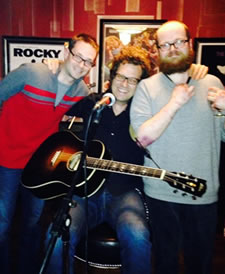
Earlier in May, I had the pleasure of going to the “Butterfly Girl” screening at the CIMM music festival in Chicago. Both my Mom and brother drove up from Peoria to attend the show plus my girlfriend corralled all of her family to make an appearance. It was great to be able to meet the director behind such a magnificent film, Cary Bell. John Evans, Abby’s father, also attended. He put on a show afterward playing a few of his favorite tunes plus a song he wrote about Abby. The screening was held at the Logan Theater in Logan Square. It’s a smaller theater that holds a few hundred people per auditorium. The place was packed! Ran into a few parents who had children with EB and a lot of supporters of the cause. Very heartwarming.
For this month’s post, I want to touch a little on what it was like growing up with EB. I learned alongside my parents trying to figure out the best way to approach things while moving through school with kids and parents who had no idea what was wrong with me. When I first started going to pre-school and kindergarten, instead of answering questions from every kid and parent that I interacted with, my mom thought it best to put together a presentation and speak in front of the class to inform the parents and children what the disease was and that it was not contagious. That happened to be the most common question (at least as far as I can remember), “is it contagious??” Children didn’t know any better but I always thought it ridiculous to have the parents ask that question as well. I would answer questions from “Were you in a car accident?” or “Were you in a fire?” My standard response, outside of sarcasm, morphed into “I have a very rare skin disorder called EB and I can fall and get scraped really easily.” Outside of the obligatory follow-up questions, that response typically covered enough in order to have kids move on to other things. The stares and the constant questions can make a kid with EB very self-conscious of his or her skin. Until I entered high school, I would always wear jeans or long pants and a long sleeve shirt because it was easier for me to be uncomfortably hot than to have to manage the questions and prying eyes of your peers. I eventually grew out of that becoming comfortable in shorts & t-shirts, but it was a long journey to get to that point. Sports always gave me a natural outlet to be viewed as an equal among my friends. I played baseball growing up and was always a pitcher. I like to think I was pretty good although I quit right before high school and picked up tennis. I obviously couldn’t slide into 2nd base when stealing but outside of that, I was pretty okay at everything else. I always went to public schools and for that, I am thankful. Through sports and public school, I learned to be self-confident. Growing up in the public school environment and being able to handle all the unwanted attention made me a more confident person today. I feel those experiences growing up gave me the ability to perform well today in my chosen field of business.
Next month (its already almost June… how time flies) I am going to be interviewing my mother who will cover what it was like having two children with EB and the challenges she faced. She has a lot of good stories and is a much better writer than I am, so I am sure there will be a lot of good that comes out of the interview.
For this month’s post, my mother has graciously volunteered to be interviewed about life growing up with two children with EB and the challenges that she faced. So without further ado, below you will find what transpired.
Andrew: What went through your head when you realized that you had a child with a rare skin disorder, EB, and you had no idea what you were dealing with?
Angie Conrad: I don’t think I hit panic until I started to research the disease. Since you were born with no skin missing; I didn’t realize it was serious at first. I think any parent is unprepared to hear that their newborn child has a potentially fatal disease. Thirty years ago, when you were born, there was little known about the disease and many of the diagnostics that are available now, were not in place then. When blisters started appearing on your hands and then healing with scars, I knew something was not right. There was a disease mentioned at the time called Epidermolysis Bullosa, but we were assured that you did not have THAT! It took visits to four different doctors before someone actually said, “I think this is serious.” We were directed to a wonderful doctor in Houston, TX named Moise Levy who specialized in pediatric EB. He was able to confirm the fact that you had the disease. I remember the horrible day you had to have a biopsy done at the Children’s Hospital. I became a member of an exclusive club of shell-shocked parents dealing with very sick children. I still remember the children in the waiting area looking scared and exhausted being held by their parents. I sat and prayed for you and for those children.
Where did you go for information to learn about how to manage a baby with EB?
There were not many places to go for information thirty years ago, but Dr. Levy gave us the information for debra of America. They were my lifeline. I also started to do research in books and on-line. Through debra of America and Dr. Levy, we were connected to other families in Houston also dealing with EB. We were informed that you had a dominant form of the disease which meant that we would not have to worry about having another child with EB in the future. When I became pregnant with your brother, I was able most of the time, to convince myself that there was nothing to worry about. Unfortunately, they had misdiagnosed you, and your brother was also born with recessive dystrophic EB. He was born with no skin on his left leg and a deformed left foot. There was stunned silence in the delivery room when he was born.
How did you figure out what bandages to buy?
Meeting other families was a huge help in trying to deal with how to take care of you. Mostly it was hit or miss on what to use and finding out what worked. I remember the first thing I did was have you sleep on a sheep skin rug in your crib. The worst times were when I inadvertently hurt you by just handling you. I remember taking a huge strip of skin off your leg with the setting on my wedding ring. I was crushed and felt horrible guilt and never wore my ring again when changing your diapers or bandaging you. Life was very difficult as you started to grow and learn to crawl and walk. Falling down was anguishing for you and me. Many times the skin from your palms or knees was completely torn off in a fall. The pain for both of us was excruciating. Many times you would pass out and I would hold you in my arms asking God to intervene. Watching your child suffer is the worst pain a parent can endure.
Kids can be stubborn so what was it like raising a child with EB who wanted to do all the normal things that a typical kid wants to do?
I decided early on that I was going to raise you and your brother as “normally” as possible. You were going to do all the things that little boys were supposed to do. You learned to ride a bike, swim, climb, play baseball, basketball, golf and anything else you wanted to do. We knew the potential consequences but refused to be held back. You knew your limitations and made adjustments.
You have mentioned to me a few times that somebody turned you in for child abuse when you were going through the grocery store with me.
You were almost four years old when we moved to Peoria, IL and I was immediately dealt an emotional blow when someone called the child abuse hotline and informed the state that she saw children who had obviously been” burned with cigarettes on their hands and bodies. That was a low point. Knowing what care I took in protecting you and being a good mother to do you and your brother, then being accused of “hurting” you was almost unbearable.
You present to my kindergarten class on EB and probably some of my later years in school. How did this come about?
After the child abuse incident, I decided to be proactive in getting the word out about EB. We held fundraisers at your preschool, we had feature articles done in the newspapers, and most importantly; I did a question and answer talk at the beginning of every school year for each of your grade school classes. The school and community became very supportive and understanding of your disease and limitations. I felt so blessed that my prayers were being answered in this way. There were always going to be people who asked “stupid” questions and make accusations, but most people are sensible and sympathetic.
Any other thoughts?
My favorite memory of you and your brother growing up was the “Little League” days.
You were called “out” at home plate for not sliding in as the rules required. All of your teammates came off the bench to explain to the umpire that you were physically unable to slide due to your disease. A huge cheer went up from your young teammates and in the stands when the umpire yelled, “SAFE.” I still tear up when I recall that memory!!I look back on what EB has taken from you and your brother, but most importantly I am able to thank God for what it has “given “ to you. We have gone places and met people through this disease that in a normal life you would have never experienced. You got to play tennis with John McEnroe and Mats Wilander ---- a dream most tennis players never realize! You and your brother have a compassion for the disabled and the underdog, which most people will never be able to relate. Even though you undergo medical procedures and endure hardships most people don’t, you never pity yourselves. I am so proud of the men you both have become.
I want to thank my mom for taking the time and sharing a little bit about what it was like being a parent with children with EB. I hope that this is helpful for all the new parents that may be going through the EB experience. I think it is important to realize that EB is not something that necessarily prevents you from accomplishing what you want to as long as you understand your physical limitations. Although the disease can be demoralizing at times, it is only physical. Parents should understand this as well. If anyone has any comments or questions for my mother, feel free to email me and I will be sure to pass them along. Maybe you will see one of your questions answered in an upcoming blog post.
Angie Conrad is the mom to Andy and Sam Conrad who both have Recessive Dystrophic EB. She the General Manager of a Christian Bookstore in Peoria, Illinois and the author of the book ,"At the Feet of Ordinary Women." You can reach her at yaz001@aol.com
Hi Friends,
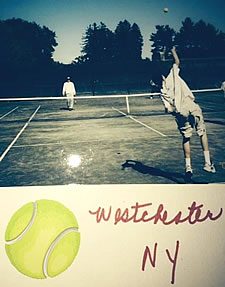
I first want to thank all of you for following my blog on debra of America’s website. I’m proud to be a Young Ambassador. It means a lot to me
that you take the time to read my stories and share them with your friends. I look forward to your emails and questions – so please keep them coming!
This past month I’ve been busy preparing for a trip to South America with my girlfriend, where we’ll be hiking to the top of Machu Picchu. I’m very excited, but also nervous about the 5-day hike and how it will affect my EB - but I’m ready to take on the challenge. My August blog post will be all about my trip and include photos. Wish me luck!
Lastly, I wanted to remind everyone about the 2nd Annual Mats Wilander Foundation Tennis Pro-Am on Wednesday, August 27 in New York City. I was able to play with Mats when I was younger and let me tell you – you do not want to miss this event. It’s a full day of tennis on 3 different court surfaces (open to all levels), and includes breakfast and lunch. You also get to play with one of the greatest tennis players in history – Mats Wilander! The best part is that all proceeds go to debra of America to help find a cure for Epidermolysis Bullosa.
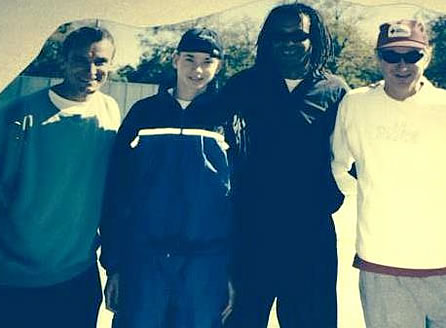
Epidermolysis Bullosa (EB) is a tough disease, as anyone who has it can tell you. Being a person with recessive dystrophic EB, I know all too well, the limitations the disease can present. I have been an avid traveler my entire life and some of the trips I have taken range from hitch hiking Madagascar to riding an elephant through the jungles of Thailand. Although all the trips have been unique in their own right, they each presented different challenges that, as a person with EB, I had to figure out how to overcome. As some of you may know, my girlfriend and I just got back from a 2 week trip to South America where we spent some time in Quito, Ecuador followed by a hike through the Inca Trail to Machu Picchu. Quito was a lot of fun as anyone who has been there can attest. I have posted various pictures on Facebook from the trip, but my focus for this blog post will be on the hike to Machu Picchu. 44 kilometers, over 10,000 steps, altitude ranging from 6,500 ft above sea level to 14,000 ft above sea level, and temperatures ranging from -6 degrees Celsius (21 degrees Fahrenheit) to 85 degrees Fahrenheit, those are just some of the highlights from our hike through the Inca Trail. The Classic Inca Trail is a 4 day / 3 night hike starting at km 82 from Cusco on the Urubamba River. It covers 44 km of terrain located in the Andes mountain range through cloud forest, alpine tundra, Quechuan settlements, tunnels and many Incan ruins before finally reaching Machu Picchu. We spent one night in Cusco before heading off to the Trail. Cusco was known as the golden city and center of the world in the Inca Culture. Cusco is one of the largest cities inside Peru with a population of around 3 million. The downtown area, which is where most of the tourists hang out, is very commercialized with a Starbucks and many high end retail shops. The town also has very good food but is a little pricier than elsewhere in Peru. We stayed at La Encantada in the San Blas neighborhood, about a 15 minute walk from the city square and would highly recommend it for anyone traveling to the area.
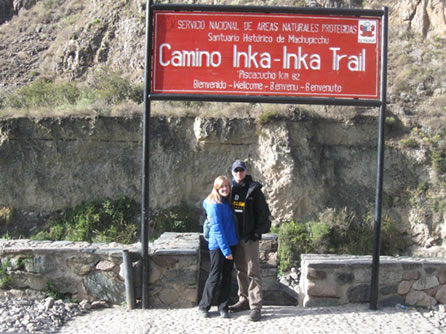 Day 1 of the hike started at 2:30am on Wednesday July 30th when we woke up to get ready for our adventure. We were picked up by the bus around 4am where we traveled 2 hours to the head of the trail. Breakfast was served upon arriving at the site around 6:30am and shortly after that we were off hiking. Our group was 10 large including Colleen and me. In addition to us hikers, we had a tour guide, Ludwig, and a guide assistant, Anthony, and 16 porters to carry all of the gear, which included sleeping bags, tents, and all the food and equipment. The first day, as we were to realize, was the hardest hiking day covering 16km of varying terrain concluding with a 3 hour up-hill hike consisting entirely of stairs. The beginning of the hike is relatively easy. We encountered a lot of pack animals servicing the numerous villages that lined the beginning of the trail. The first real Inca ruin that we visited was Wilkarakay, a site that was used for crop production servicing the Inca Trail. The first day primarily follows the Urubamba & Kusichaka Rivers and their tributaries. We reached our lunch spot around 1pm at an Inca ruin called Wayllabamba. At every Inca ruin site, our guide would give us the full run down of the history of the site along with certain background on the Inca culture that over the course of the hike, would give you a full understanding of the reasons behind Machu Picchu. For a majority of the tour companies, this is their first night camp site. The trail also begins its ascent to Abra Warmiwanusca, also known as “Dead Woman’s Pass”, which is the highest peak on the trail at nearly 14,000 ft elevation. All of the meals while on the hike were simply amazing. Lunch and dinners were typically served buffet style and consisted of traditional Peruvian cuisine. Feeding 12 people three meals a day for 3 straight days was quite an undertaking and every meal was fresh and delicious. Without a doubt, the meals we had on the hike were some of the best meals we had the entire vacation.
Day 1 of the hike started at 2:30am on Wednesday July 30th when we woke up to get ready for our adventure. We were picked up by the bus around 4am where we traveled 2 hours to the head of the trail. Breakfast was served upon arriving at the site around 6:30am and shortly after that we were off hiking. Our group was 10 large including Colleen and me. In addition to us hikers, we had a tour guide, Ludwig, and a guide assistant, Anthony, and 16 porters to carry all of the gear, which included sleeping bags, tents, and all the food and equipment. The first day, as we were to realize, was the hardest hiking day covering 16km of varying terrain concluding with a 3 hour up-hill hike consisting entirely of stairs. The beginning of the hike is relatively easy. We encountered a lot of pack animals servicing the numerous villages that lined the beginning of the trail. The first real Inca ruin that we visited was Wilkarakay, a site that was used for crop production servicing the Inca Trail. The first day primarily follows the Urubamba & Kusichaka Rivers and their tributaries. We reached our lunch spot around 1pm at an Inca ruin called Wayllabamba. At every Inca ruin site, our guide would give us the full run down of the history of the site along with certain background on the Inca culture that over the course of the hike, would give you a full understanding of the reasons behind Machu Picchu. For a majority of the tour companies, this is their first night camp site. The trail also begins its ascent to Abra Warmiwanusca, also known as “Dead Woman’s Pass”, which is the highest peak on the trail at nearly 14,000 ft elevation. All of the meals while on the hike were simply amazing. Lunch and dinners were typically served buffet style and consisted of traditional Peruvian cuisine. Feeding 12 people three meals a day for 3 straight days was quite an undertaking and every meal was fresh and delicious. Without a doubt, the meals we had on the hike were some of the best meals we had the entire vacation.
After lunch, we began the 3 hour hike up hill to get 3/4th of the way up to the peak of Dead Woman’s Pass. The stairs combined with the high altitude made this part of the hike the most difficult portion of the entire trail. For the last hour and a half, we would hike for two minutes followed by a one minute break because 120 seconds of stairs uphill made you feel as though you had just finished a marathon. By around 4:30pm, we all stumbled into camp exhausted and thrilled to have completed our first day on the Inca Trail. Dinner was served around 5:30pm and shortly after, everybody retired to their tents and went to sleep. At one point, Colleen said I fell asleep at the dinner table sitting up. She was talking to me and I ended up just staring off into space for about 15 minutes. It was a long day. Remember when I mentioned that the temperate dropped to 21 degrees Fahrenheit on the trail? Shortly after dinner it started to rain and quickly converted into snow. Around midnight, the temperate dropped below 0 Celsius and stayed there until we woke up. Needless to say, it was a rough welcoming to sleeping on the ground in a tent in the Andes Mountains.
Day 2 started at 5:30am when we were greeted with a wakeup call and coca tea. Coca tea is basically highly caffeinated green tea and 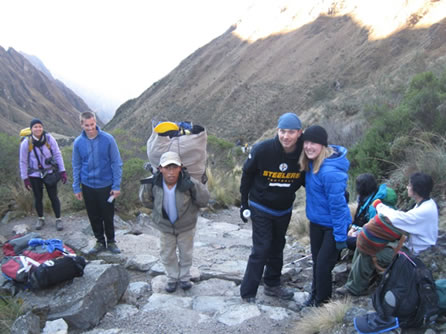 very tasty. It also helps with the altitude. Breakfast was served and we were on our way a little before 7am. The first part of the hike was a continuation of the end of day 1, an hour and a half hike up hill with stairs to the peak of Dead Woman’s Pass. The view from the pass was absolutely stunning. The Inca Trail is located through the Sacred Valley of the Andes Mountains and from the peak you could see down the valley all the way to the river tributaries. Above the tree line and in the mountain tundra, it was cold and windy but well worth the reward for putting in extra work the 1st day.
very tasty. It also helps with the altitude. Breakfast was served and we were on our way a little before 7am. The first part of the hike was a continuation of the end of day 1, an hour and a half hike up hill with stairs to the peak of Dead Woman’s Pass. The view from the pass was absolutely stunning. The Inca Trail is located through the Sacred Valley of the Andes Mountains and from the peak you could see down the valley all the way to the river tributaries. Above the tree line and in the mountain tundra, it was cold and windy but well worth the reward for putting in extra work the 1st day.
We also hit the 2nd highest peak on the 2nd day and arrived into camp around the same time as the first night, 4:30pm. The night was cold but not nearly as cold as -6 degrees below zero. We discovered that if you fill up your water bottle with boiling water, you can use it as a heater inside the tent so that helped with the temperature. Finishing day 2, we knew that we were almost there and the next two days of hiking were about the enjoyment of the trail.
Day 3 was comparably much easier than the prior 2 days. We only hiked about 5 hours and were done by 1:30pm; however, this day was the most beautiful. We had started our decent on the other side of the sacred valley into the cloud forest. The cloud forest is part of the subtropical evergreen forest that is characterized by a persistent, low-level cloud cover. The entire forest is very green and covered by a lot of mosses and ferns. The temperate was markedly warmer with temperatures in the 80s and humid. On this day, we came to my favorite archeological ruin, Intipata. Intipata was a large farming site complete with a number of grain houses and residences. It was on top of a large valley looking down onto the Urubamba River. The site also had three llamas that were free roaming. This was a ton of fun as we got to take many pictures with them as they wandered about. During story time with our guide as we were all sitting in a circle, a llama snuck up behind Colleen and actually bit her leg. She screamed while everyone turned around to view a llama up close and personal with Colleen. Unfortunately, nobody was able to get this on camera. Winay Wayna was the 2nd archeological site for the day and our reward for doing extra work on day 1 & 2. Winay Wayna is Quechua for “Forever Young.” This was another site overlooking the valley down to the river; however, no llamas at this site. The view however might have been better than Intipata.
Andrew Conrad on Inca Trail
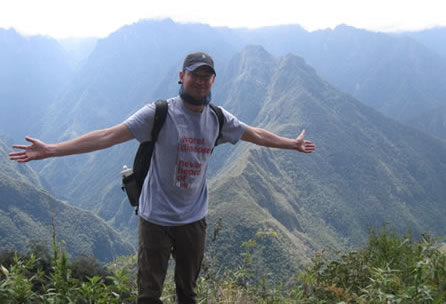 Day 4 was another early start but also the day we would finally reach Machu Picchu. At the end of day 3, we were able to see the back side of Machu Picchu Mountain, but day 4 is when you start to hear the train whistles blow from Aguas Calientes town and realize you are dangerously close to being back in civilization. The morning began at 2:45am with a wakeup call. There is a check point that is 5 minutes from the camp site that determines your entrance onto the final trail to the Sun Gate. At each checkpoint, the guide has to sign a few papers and get everyone’s Inca Trail ticket stamped. At the last camp site, everyone from the beginning of the Inca Trail has finally caught up and there is roughly 200 campers all waiting. So if you sleep in, you will be waiting an hour or more to get onto the trail. The goal is to be as close to the front of the line as possible in order to have the chance to be one of the first groups to the Sun Gate. The Sun Gate, or Inti Punku, is the point at which the hikers get their first glimpse at Machu Picchu. The trail to the Sun Gate is a narrow trail that typically takes about an hour and 20 minutes. We were the 4th group in line and reached the Sun Gate in 57 minutes being the 2nd group to the finish. Half the trail in the morning is in the dark as the check point opens around 5:30am. There is something to be said about running to the Sun Gate in the dark with head lamps on. What an experience.
Day 4 was another early start but also the day we would finally reach Machu Picchu. At the end of day 3, we were able to see the back side of Machu Picchu Mountain, but day 4 is when you start to hear the train whistles blow from Aguas Calientes town and realize you are dangerously close to being back in civilization. The morning began at 2:45am with a wakeup call. There is a check point that is 5 minutes from the camp site that determines your entrance onto the final trail to the Sun Gate. At each checkpoint, the guide has to sign a few papers and get everyone’s Inca Trail ticket stamped. At the last camp site, everyone from the beginning of the Inca Trail has finally caught up and there is roughly 200 campers all waiting. So if you sleep in, you will be waiting an hour or more to get onto the trail. The goal is to be as close to the front of the line as possible in order to have the chance to be one of the first groups to the Sun Gate. The Sun Gate, or Inti Punku, is the point at which the hikers get their first glimpse at Machu Picchu. The trail to the Sun Gate is a narrow trail that typically takes about an hour and 20 minutes. We were the 4th group in line and reached the Sun Gate in 57 minutes being the 2nd group to the finish. Half the trail in the morning is in the dark as the check point opens around 5:30am. There is something to be said about running to the Sun Gate in the dark with head lamps on. What an experience.
So after 4 days of hiking covering approximately 28 miles over 10,000 steps and many different clothing changes thanks to the constant climate differentials, we, as a group, finally made it to Machu Picchu. Initially, I was nervous about how my body would hold up on the hike but it held up remarkably well. By the 4th day though, my feet were ready to be done. One of the most difficult parts of the trip was trying to keep wounds clean as you don’t get to shower for 3 days and the water isn’t exactly the cleanest. During one of the first days in Quito, I managed to ding my leg pretty good and struggled to keep it clean for the hike. It all worked out in the end. I also had to answer a lot of questions while on the trail from some of the hikers in my group, which was great since the questions were thoughtful and showed an interest in learning more about the disorder. The “Worst Disease” t-shirt helped as well! Overall I am super happy to have accomplished a hike that very few people have completed. Hopefully I can continue to prove that even though you may have recessive dystrophic EB, there is nothing that you can’t accomplish. What a great trip!

When I started writing about EB for debra of America, I wanted to convey many of my experiences about the disease and how I have dealt, but I didn’t anticipate much of the outreach that I have received since I started writing in March. Over the past 7 months, I have received emails from the Philippines, Ireland, and New Zealand as well as many places all over the United States. It has been inspiring to hear from parents of children with EB or individuals who have EB and how they tackle many of the instances I have written about. One email in particular struck me as especially inspiring. Shortly after my September post about my travels in South America, I received an email from Karen. She was born with recessive dystrophic EB and has lived a long and successful life, having a professional career while being a wife and a mother of 2. As a result of her correspondence, I reached out to her and she sent me a great story on her life growing up with EB. Rather than try and paraphrase, the following is what she sent me in its entirety.
Thoughts From A Soon-To-Be Septuagenarian With Recessive EB
I’m a 68 year old adult with Epidermolysis Bullosa. I was talking to my sister recently and was amazed to hear myself say, “I’ve come to realize that EB is a part of me, the good and the bad. I just can’t separate myself from it.” That moment of truth was amazing because until I was 35 years old, after the birth of my second child, I couldn’t even talk about EB with anyone without severe anxiety, including doctors.
I was born in 1946, the first of the post war baby boomers. There was no known history of skin disorders in either of my parents’ extended families. At birth, my grandmother, who had one of her own children die of burns, was convinced that I, too, had been burned. When I was about 6 months old, we moved to a small town near Kansas City, where, at one year old, I was finally diagnosed by a dermatologist, a Dr. Denny. Until this time, the reason for all my injuries, skin, mouth, etc., many of which seemed to occur without provocation, was a source of bafflement for our family doctor.
Although I have no memory of my infancy and young childhood, I know it was painful. (For much of my life I experienced unexplained fear and panic whenever I would see a very young child lifted from under the armpits.) During my school years I had injuries that would cause me to miss school at times, and spasms in my esophagus that could turn any dining episode into a traumatic event that typically lasted for hours. At these times I was instructed by well-meaning adults to stand on my head, eat bread, drink water, cough, swallow hard, spit - all of which only made the problem worse.
From an early age I taught myself to tend to my own wounds, a painful experience that I didn’t trust anyone else to manage. While sports were not an option for me, I tried a few anyway. I soon learned to make appropriate choices about what I could and couldn’t do. Walking was always fine if my shoes didn’t rub, and I even learned to ride a bicycle by starting with training wheels. Jump rope was fun, and hula hoop could keep me engaged for hours. My parents and siblings were athletic, but they had the good sense to let me make my own decisions, and they never tried to stop me when I made a risky choice or blamed me when that choice resulted in an injury. Although their heated disagreements with each other resulted in divorce, I always sensed that they were together in their support of me and my efforts to deal with EB. During this time I also learned to take responsibility for amusing myself, to be persistent and to cultivate my imagination – three skills that have always served me well.
There was almost nothing known about EB in my youth, and no organization supporting patients or their parents. Through Dr. Denny, my mother had been in contact with a farm family in Iowa whose little girl had a more severe case of EB than my own. Although my hands and feet were always sore, hers were webbed. We visited them, and I recall a moment when my mother and I were sitting at a the kitchen table with the girl’s mother. She made the comment, “They say they’re not very smart.” My mother responded, “Not true! Karen is the smartest in her class.” I didn’t regard myself as the smartest in my class, so I assumed from that point that I was likely not smart, as a result of having EB. This attitude stayed with me all the way through college. I had decided that even when I did well in a subject, I would eventually be revealed as stupid. Thankfully, I was to realize much later that this wasn’t true.
In the ‘60s I went to a public high school in Tampa, Florida that was a top football school. I was in the “Adaptive P.E.” class of about 10 students, which meant we hid in a room, unsupervised, and had plenty of time for conversation instead of taking part in sports. I realize we could have benefitted from some type of health education, but actually we benefitted from the opportunity to meet others who had physical disabilities, even though conversations about those specific disabilities were taboo. Outside of gym class, we just nodded politely when we saw each other in the hall, never revealing the basis of our common understanding.
I describe all of this to establish what EB was like for me as a child, both physically and emotionally. In my youth, followingWorld War II, child psychology wasn’t in high regard. The ideal upbringing for a child with a disability stressed avoidance of self-pity, which assumed the ability to endure emotional and physical pain in secrecy. My point in mentioning these experiences is to stress that I believe it is important for parents to understand that they can’t protect their child from injury or prejudice, and it is important to have conversations with their child and others about EB. At the same time, parents also need to have confidence that their child will find some solutions entirely on his/her own.
Mine is neither the most or the least severe case of recessive EB, and I realize that some children don’t have the same potential for recovery that I had. It is amazing that my EB got better each decade of my life after my 20s. Today, to most people who don’t look too hard, I look like everybody else. I still am easily injured, but not to the degree I once experienced. I still grapple with issues that are directly or indirectly related to EB, particularly concerning the mucus membranes. I have esophageal dilations annually and I have taught myself to “reverse swallow,” which allows me to bring up food that is caught in my esophagus. I have had surgeries for rectal fissures, a colostomy and a reverse colostomy; I have lost all my bottom teeth and have had them successfully replaced by implants. A trip and a fall can still cause deep injuries, but I am an expert at wound care and know the importance of avoiding infection. However, I continue to live in fear of severe, accidental injuries where I might wind up in an emergency room and have to rely on overly zealous healthcare professionals or well intentioned people whose reactions are too aggressive.
On the other hand, through recommendations and experience I have assembled a great team of doctors and dentists who are compassionate and willing to research every problem I have. I am very grateful to them. As for therapists, I have had a couple who made a real effort to understand. (I am put off by people who say, “You can’t understand what I’m going through unless you’ve had the identical experience.” I believe it is possible and necessary to find people who are empathetic, and to assume that some have dealt with their own problems.) With difficulty, I managed to give birth to two healthy children, neither of whom have EB, and both of whom have become successful adults. One has produced a healthy child of her own.
Because of EB, I spent years of my earlier life in denial and secrecy, a way to cope with the reactions of others - both adults and children my own age. How could they possibly know that this wasn’t a contagious disease? When I was asked why I had so many sores or no fingernails or toenails, I said I had an “allergy.” But that just gave me something to say, and I realized nobody really truly believed it. Today when asked, I explain without stress that I have a congenital skin disorder, and I don’t worry about whether they understand it or not: it’s complicated.
I no longer try to curl my fingers tightly so people can’t see my hands. The scars on them show evidence of EB and have no fingernails, but they aren’t always red and sore looking, like they used to be. In my 20s I decided if I would never have beautiful hands, I would have useful hands. Today my hands allow me to paint and produce art that is better than average and they support my brain in computer work, among many other things.
I managed to reassure myself about my intellectual capabilities enough to have completed a master’s degree and to have held a professional job until my retirement in 2012. Most amazing to me, I have managed to be married to the same man whom I first met in 1969 and married one year later. He has accepted me and helped me through many a physical crisis, most of which were directly or indirectly related to EB. Similarly, when he faced some unexpected physical emergencies, I am proud that I was able to support him. I have been a good mother, but I will admit with regret that when my children had a minor “boo-boo”, I may have been too quick to brush it off without recognizing that even a minor injury was major to them.
I doubt that I will continue to improve past this point; even people with normal skin develop problems in old age, and I don’t expect to be an exception. However, in old age I have come to understand that life has its surprises. I want to be open to them.
In retrospect, I realize that not knowing what to expect was one of the hardest things I had to deal with. I believe that children, parents, healthcare and mental health professionals need to hear more from older people who are successfully dealing with EB. The stories aren’t all there yet, but they need to be told.
- Karen Graham
Happy Holidays!
In keeping with the personal story theme of posts that started with last month’s addition from Karen, I am following up with another. Shortly after I posted the story of Karen last month, I received an email from Brian who shared a heartfelt narrative about his experiences with EB. His story is one that I am sure many people with EB can relate to. Brian tells how he grew up avoiding conversations about EB with people, the limitations EB presents, and starting a family. As Brian mentions in his story, this is the first time that he has put the pen to paper about EB and I am so grateful that he did!
The Story of Brian Amos
Hello to everyone. My name is Brian Amos. I am 37 and have EB. It has always been hard for me to say that!
When I saw kids that had the disease much worse than I did, I always thought, “I don’t have it that bad.” When I would play with my “normal” friends I always knew I was different than them. I have never once had a conversation with anyone that has EB so I have never once been able to compare stories with anyone that has EB. I have, in a way, always run from or avoided anything that has to do with EB. I wasn’t embarrassed to have EB or embarrassed of the way I looked, but I was frustrated with the limitations. Many of the things that your mother and you have said in a previous blog post caused many memories to rush back to me. Occasionally my two sisters, two brothers, mom or dad would bring up something and I would quickly brush them off so that we didn’t have to discuss my condition. I have always tried to put my limitations aside and do whatever it was that I wanted to do. Afterwards, I would deal with the consequences and pain so that I could continue to live in the moment. That was just my reality -- play now but pay for it later.
The hardest thing about having EB is not the pain or the discomfort; it was the constant questions. I could always understand or expect the first question-- it was the follow-up questions that drove me nuts, or the awkward “yeah that happens to me too” or the trying to be funny comment. I dreaded meeting new people or walking into a room, because I knew the questions were coming. If I could just get past that first question, I knew my sense of humor or personality could win them over. No matter what I did to try to avoid it, that first question of “What happened to you?” was always going to be there. Even as a youngster, I could understand why people wanted to ask the questions; however, I simply grew tired of answering it. I tried to stop the questions by wearing long-sleeved shirts that would cover most of the outward appearances of the disease, but there would always been that one person who would notice my hands and ask. My heart would sink. Those are my memories.
This gives you an idea of my childhood pain; however, it pales in comparison to the decision I had struggled to make over the last six years--the decision to have kids. I never thought I would have kids, because I knew I had a 50/50 chance of passing on the disease. I selfishly said, “No, I don’t want to pass this on.” When my wife and I got married, we never really thought or talked about it. We were living life and having fun. Then one day we talked and realized there was nothing we wanted more than a child. Despite how difficult it was to grow up with EB, I was reminded by my family of how great of a person I turned out to be. I decided if my child happened to be born with the disease, knowing what I know, it wouldn’t be that bad. When our first son, Oliver, was born, it was the most amazing thing that I have ever witnessed; however, the hours after were the most agonizing. I looked at the skin around his bracelets and examined his hands for the first few hours until my dad pulled me in the hallway and said “son he’s alright, he doesn’t have it.”
My ignorance surrounding EB, even though I have had it my whole life, was very evident to me three years later when we welcomed Sydney into our lives. Our baby girl was born and had no signs of EB until we brought her home and I took the band- aid off of her foot. That is one moment in my life I will never forget. I knew instantly what was wrong. I knew at that point she was going to live with that question. Sydney is almost eight months old and is doing great so far. She has some break outs on her neck, hands, feet and legs but is an incredibly strong little girl. She doesn’t even realize there is anything “wrong”. She is so amazing. Her brother is blessed beyond his wildest dreams because it’s going to make him that much better of a person. Oliver likes to help change her bandages and corrects me when I forget to put Vaseline or cream on a certain spot.
Lastly, the most amazing result that has come from both my daughter and me having EB is my wife Natalie’s response. My wife does not have EB. When Oliver was born and didn’t have it, I would let her know how “lucky” we were. When Sydney came into our lives, I understood that this would be a difficult endeavor but my wife had no way of knowing. She never wavered or told me to deal with it; she instantly stepped up to the plate. She spent time researching while asking questions and learning to care for Sydney. She has been the most amazing part of this whole experience for me, because I didn’t think people unfamiliar with EB could just jump in without asking why or blaming others. She has taken EB and turned it to a positive! She has decorated Sydney’s Room in butterflies. She wears her EB shirt and she wears her “ask me about EB” pin proudly. I have never been more amazed with my wife who gives 100% unconditionally without having known anything at all about EB. She is making the best of a very tough situation.
I’m not sure why I did this today. I stumbled across your blog and it pulled this out of me. I have never shared these thoughts before and it has taken me a few hours to do so. This has selfishly always been my “problem” even though I know deep down that my Dad, Mom, both Sisters and brothers have also sacrificed a lot. For me, I always felt this EB burden is mine and I have to deal with it. I have learned that my experiences with EB are no longer just mine--I have a story to tell! That is what my daughter has taught me.
Brian
In 2017, debra of America welcomed Andrew back as a contributing blogger for debra of America's blog, EB, etc.!



